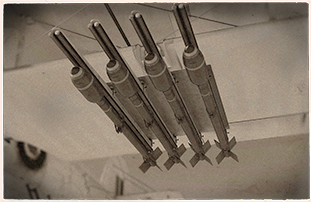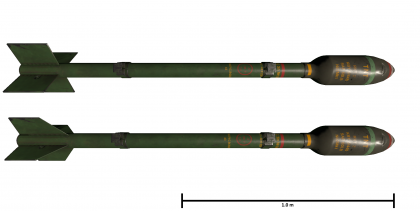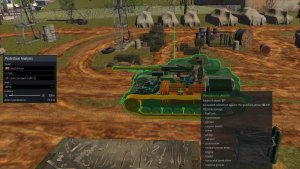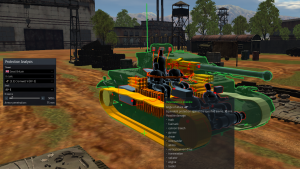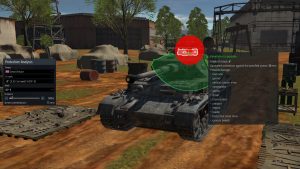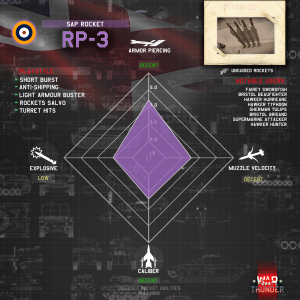RP-3
Contents
Description
The RP-3, also known as the 60-pounder rocket due to their Semi-Armour Piercing (SAP) warhead. This rocket was developed by the British military during World War II. In the game, these rockets are the backbone of many of the Royal Air Force's aircraft when fighting against both ground and naval targets. They served honourably with the Beaufighter twin-engine strike fighters during anti-shipping and anti-submarine duties. These rockets also served with the Typhoon fighters and their swift high-speed strafes against German tank and mechanized vehicle convoys.
Ground-to-ground usage though was limited, was a viable option. Decorated units such as the 1st Coldstream Guards used them during the crossing of the Rhine river, in command of their Sherman "Tulips". The ground forces would generally use the RP-3 as a weapon for saturation bombardment and counter ambushes. Thanks to the explosive splash of the warhead, it was highly effective when used for this purpose.
The rockets were widely successful and remained in use long after the resolution of World War II.
Vehicles equipped with this weapon
| Vehicles equipped with this weapon | |
|---|---|
| Fighters | |
| Hawker | Hurricane Mk IIB/Trop · Typhoon Mk Ib · Typhoon Mk Ib/L · Tempest Mk II · Tempest Mk V · Sea Fury FB 11 · ◘Sea Fury FB 51 |
| Supermarine | Spitfire F Mk XVIIIe · Spitfire F Mk 22 · Spitfire F Mk 24 · Seafire FR 47 |
| Twin-engine fighters | Hornet Mk.I · Hornet Mk.III |
| Jet fighters | |
| Gloster | Meteor F Mk 8 G.41K · ▄Meteor F Mk.8 · Meteor F Mk.8 Reaper |
| Hawker | Sea Hawk FGA.6 · ◘Sea Hawk Mk.50 · ◄Sea Hawk Mk.100 |
| de Havilland | Vampire F.B.5 · Vampire FB 52A · ▄Vampire FB 52A · Venom FB.4 · Sea Vixen F.A.W. Mk.2 |
| Supermarine | Attacker FB 1 · Attacker FB.2 · Swift F.1 |
| Strike aircraft | |
| Blackburn | Firebrand TF Mk IV · Firecrest · Buccaneer S.1 · Buccaneer S.2 |
| Bristol | Beaufighter Mk X · Beaufighter Mk 21 |
| Fairey | Firefly F Mk I · ◘Firefly F.Mk.IV · Firefly FR Mk V |
| de Havilland | Mosquito FB Mk VI · Mosquito FB.Mk.26 |
| Hawker | Hurricane Mk IV |
| Westland | Wyvern S4 |
| Bombers | Brigand B 1 · Shackleton MR.Mk.2 · Swordfish Mk II |
| Medium tanks | Cromwell V (RP-3) |
Remarkable users
Naturally, some vehicles might have certain advantages that allow them to use the RP-3 more effectively:
- Hurricanes - Due to their agility, resilience, sufficient payload and low battle rating, they can serve as dedicated ground strike aircraft, just as they served in real life. A master example is the Hurricane Mk IV.
- Swordfish Mk II - Despite being an old and very, very slow naval plane. The RP-3 turns it on a dangerous opponent, small patrol boats are totally annihilited with the RP-3 payload . It enjoys low battle rating battles with poorly armoured vehicles, a perfect combination.
- Meteor F Mk.8 Reaper - Just the fact of having one of the highest number of RP-3 available to launch, make this jet fighter a superior ground attack platform choice to test the RP-3.
- Cromwell V (RP-3) - This variant is highly unique and powerful at the same time. The RP-3 increases the potential of this Cromwell variant.
- Typhoons, Beaufighters and Sea Hawk FGA.6 are also extremely good users of the RP-3.
General info
| Rocket characteristics | |
|---|---|
| Mass | 43.1 kg |
| Maximum speed | 260 m/s |
| Explosive mass | 5.44 kg |
| Explosive type | TNT |
| Penetration | 44 mm |
The rocket is divided into two main components:
- The Semi Armour-Piercing High-Explosive (SAP-HE) warhead (152 mm) with 5.44 kg of TNT explosives.
- The "3-inch" rocket propellant body, the "3-inch" designation referring to the diameter of the rocket motor tube (76 mm), which is also shared with analogues of the RP-3, the AP Mk I and AP Mk II, referred to as the 25-pounder rockets due to their solid Armour-Piercing (AP) warheads.
The maximum velocity of the rocket is 260 m/s, which is enough to account for minimal corrections at close range. However, trajectory drop is a noteworthy concern, especially at long range (+400 m).
The warhead weight is 27 kg and the rocket engine tube weight is 37 kg.
Effective damage
These rockets will create a lot of damage post-penetration thanks to the SAP characteristics. If the target is too far away to get a successful penetration of the armour (beyond 1,500 m). The explosive air blast damage can cause splash damage which is able to penetrate up to 44 mm of armour in any direction, along with the overpressure damage.
The air blast of HE devastation was dreaded by the crews of light vehicles, half-tracks, and tank commanders; who at times preferred to abandon their vehicles during rocket attacks. This level of lethality can also be put to satisfactory use in War Thunder against the great variety of light vehicles and medium tanks, especially those in lower battle rated battles.
Some examples from the ballistic analysis prove the lethality of the RP-3 against ground targets:
Comparison with analogues
Difference over bomb ordnance
The rocket payload allows you to aim more flexibly to one or several targets depending on the ability to efficiently spare them. While the bombs despite being more powerful and deadly, lack in numbers. This is a shared trait of most of the RAFs aircraft equipped with these two ordnance choices.
Another advantage over the bombs is the possibility to destroy a target from greater distances, without the need to pass over the target or get closer for a bomb run. This, however, means the pilots should be well versed in the trajectory drop of the rockets.
One of the main drawbacks of these rockets is the lesser efficiency on heavier armoured vehicles, for example, the Maus, KVs, destroyers, and cruisers.
Usage in battles
The RP-3 rockets thanks to their versatility, work great in several battlefield environments and situations in War thunder.
The main aspects pilots should commit to always keep in mind are the following:
- The designated target
- The angle of approach
- Correction of the rocket trajectory drop
- Once in the air, everything will be diminutive and hard to distinguish. The pilot will need to guide according to the allies calling targets or seek them on his own with the granted privilege of witnessing the developing battlefield beneath him. Once they find a suitable target that is capable to engage and likely to destroy, e.g., a panzer IV. You should proceed to the next step.
- With a good angle of approach, the pilot prepares his plane correctly and ensures better probabilities of the strike upon the first pass. If a pilot uses roll banking too carelessly or in a hurried manner after the first enemy he sees, he will likely fail to strike. This granted to his inability to correct aerodynamically his angle of approach before opening fire and the likely deviation of the trajectory of the rocket, this is known as sideslip. The pilot must seek to align appropriately his sights and take in consideration the motion on his plane after any turn before opening fire. Using the roll axis to centre the aircraft's motion straight ahead. Once you've successfully positioned your angle of approach proceed to the next step.
- The question now lays in when to open fire. It's recommendable to practice the drop to get a better feel of when to fire. Using a salvo for a ranging attempt is considerable. Always keeping in mind the dangers or the zone such as anti-aircraft fire or enemy planes. If needed. You can always barrage the whole target and disengage.
Arcade Battles
In arcade battles equipping this rockets will grant you with a steady and constant ground strike weapon. Capable of destroying Medium tanks and Pillboxes with ease.
Pros and cons
Pros:- Great damage for light and medium tanks up to 5.0 battle rating
- Useful balance in explosive mass, armour penetration and velocity
- Low weight allows for a considerable amount of rocket payload, up to 16 in some planes
- Explosive warhead possesses good high-explosive damage post impact
- 152 mm calibre of the warhead will cause major damage
Cons:
- They struggle to pierce heavy armour 5.0+ battle rating, notably against Soviet sloped armour
- Muzzle velocity is the less favourable aspect, a lot of correction is needed
- The 152 mm calibre of the warhead might detonate with non-relevant objects
- No time fuze of any sort. Only ground and naval strike use
History
Examine the history of the creation and combat usage of the weapon in more detail than in the introduction. If the historical reference turns out to be too long, take it to a separate article, taking a link to the article about the weapon and adding a block "/History" (example: https://wiki.warthunder.com/(Weapon-name)/History) and add a link to it here using the main template. Be sure to reference text and sources by using <ref></ref>, as well as adding them at the end of the article with <references />.
Media
Excellent additions to the article would be video guides, screenshots from the game, and photos.
See also
External links


